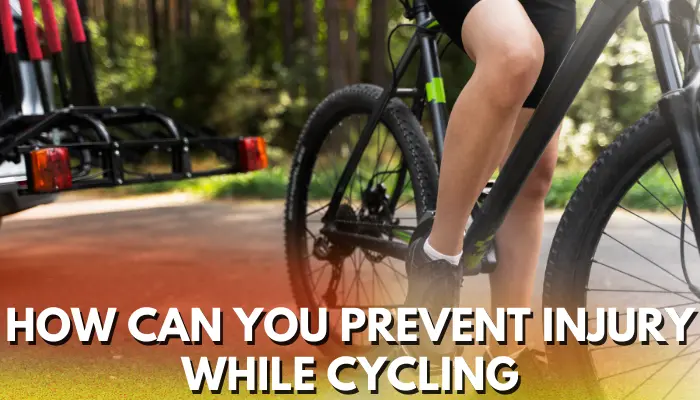How Can You Prevent Injury While Cycling

If you ride a bicycle, you are pretty familiar with the wonderful experience of the sunlight on your shoulders, the wind in your long hair, and the ground sliding under your shoes.
It can be peaceful to pedal forward when hearing your tires humming and enjoying the consistent beat. It’s an excellent stress reliever to get clean air and work out your muscles.
But how can you prevent injury while cycling? It’s an activity that offers a lot of medical advantages, namely minimal strain on the body, focus on major muscle regions, enhancement of cardiovascular endurance, and hardening of joints.
Despite the fact that it appears to be the perfect activity, there seem to be dangers and injuries that can be prevented with the right planning, equipment, and protective measures.
Table of Contents
How can you prevent injury while cycling: Preventions

There are numerous wounds and unpleasantness that you can experience without experiencing a tragic incident, but accidents and slips may end in more significant bicycle injuries.
When you cycle repeatedly, the most frequent inconveniences comprise blisters, muscle strain, and bodily aches and cramps. Let us discuss some common injuries in cycling.
- Back and Neck Pain
Even though riding a bicycle can feel wonderful, you might already be conscious that your spine and neck can easily be turned into your deadliest rivals.
Sadly, the reality is that our bodies were not intended to spend prolonged periods of time with an abnormal distribution of weight in a bicycle seat.
Darn! Our necks and upper back are stretched into weird positions, which sometimes results in pain. Long hours of traveling on uneven dirt tracks can stress you down.
Get off and stop for a moment if your neck and back start feeling fatigued during your ride. When you are seated in the saddle.
Keep in mind your posture is right by tightening your core, straightening your head and torso, dropping your shoulders, keeping a lifted chest, and gently lowering your chin.
As you adjust the handlebar’s level and stem height, make sure that you match your bicycle to your body. Last but not least, make adjustments in your shoulder and neck muscles by concentrating on them whenever you exercise frequently.
- Forearm and Wrist Pain
When you cycle, you can experience carpal tunnel syndrome. As per the HSS, “the medial neuron, that travels from the thumbs to the ring finger, is enclosed in the carpal tunnel, which itself is positioned in the palm.
During cycling, applying quite so much body weight here can induce symptoms such as discomfort in the wrists when rotating it or loss of sensation and numbness in the fingers.
A slight bending in the elbows, loose wrists, and appropriate placement of the neck and spine are all mostly crucial for pain prevention. To reach these postures, readjust your cycle handlebars.
The hands and wrists can be cushioned and kept comfier by using gel gloves. It can help add another layer of safety to your hands and fingers in the case of an accident.
- Knee Ache
How can you prevent injury while cycling? Well, when you are out cycling, knee pain may become unbearable. In a way, the knee functions as a pivot among your hips and ankles. Complications can occur if the gaps in between are too close together or possess different intensities.
Anterior knee pain, which is soreness at the front of the knee, posterior knee pain, and lateral or medial knee pain (pain on the sides of the knee) are the 3 most prominent forms of knee pain among cyclists on the road. The two most common reasons for knee pain are muscular stiffness and poor bike fitting.
- Patella Tendinitis, Achilles Tendinitis, and Patellofemoral Syndrome
The type of injury that occurs most typically in bicycling is a patellofemoral syndrome. This seems to be frequent pain in the front part of the knee and the region around the kneecap (the patella). Patellofemoral pain can be prevented by conserving endurance and strength, using appropriate posture, and exercising consistently.
While cycling for beginners, damage to the tendon that attaches your patella (kneecap) to your lower leg is termed patellar tendinitis. In order to stretch your knees, so you are able to strike, run, and hop, the patellar tendon interacts with the muscles at the front of your thighs.
If you suffer from patellar tendinitis, develop good posture and practice your activity, build up the muscles supporting your knee, and put ice on the affected region if you start to experience soreness when you are walking about.
Similar to the above, “Achilles tendinitis is an injury that occurs due to overuse of the Achilles tendon, the strip of tissues that connects the calf muscles at the back of your rear leg to your shin bone”.
By steadily increasing your amount of physical activity, gradually building your leg muscles, exercising, using pain-relieving shoes, and cross-training, you can reduce the risk of developing Achilles tendinitis.
- Saddle Sores
Saddle sores, to put it in simple terms, are not in any way entertaining. Talking about cycling saddle injuries, those unpleasant skin conditions that could develop on the regions of your body in connection with your saddles may be familiar to you.
The most typical kinds of saddle sores are folliculitis, furuncles, ulcerations, and friction. These inflamed, burning sores can indeed be put on by inflamed hair follicles and epidermis, which have been rubbed bare to different degrees.
How can you prevent injury while cycling? Well, by using chamois lotion, wearing the appropriate bike shorts or a padded base layer under looser fitting underpants, utilizing a properly adjusted saddle, switching your shorts as quickly as your trip comes to an end, and having a properly sized saddle, you can minimize saddle sores.
- Shattered limbs
The ribs, wrist, hand, femur, humerus (upper arm), and clavicle (collarbone) are indeed the bones that fracture the most typically.
Even though crashes can sometimes be inescapable, there seem to be ways to avoid sustaining damage if you tumble from your bicycle. Learning impact-reducing strategies could assist in decreasing the probability of breaking a bone if you do find yourself in a tricky situation.
- A Head Injury
We have been advised to wear a helmet, and we need to all do it. Regardless of the fact that it may not be a legal requirement in so many states, it is the finest method to safeguard you from even the most serious types of accidents.
Sadly, more than 60 percent of deadly bicycle accidents involve traumatic brain injuries. Up to 75 percent fewer head and brain injuries can happen when you safeguard your skull by putting on a safety helmet.
- Cycling-Related Road Rash
While cycling on roads, cycling-Related street rashes result from slipping from your cycle and scraping your flesh against the ground.
Cyclists suffer through one of the most painful yet widespread wounds. If you are experiencing road rash, gently remove any road debris which has been left on your body by offering your injury a thorough cleaning.
After cleaning, wipe yourself down, apply an antibacterial ointment, wrap the injury, and renew the bandages on a daily basis. If your wound becomes severe, watch out for dangerous diseases and also get immediate help quickly!
Make safety a priority

We must take extra precautions to ensure that cyclists and automobiles can interact peacefully on the roadway since we share it with both.
- Improve the Visibility
Consider it taken for granted that drivers can’t notice you. Make every effort possible to enhance your awareness so that tragedies can be minimized.
Use flashy clothes, headlights, and reflectors, and cycle where pedestrians and motorists can easily see you. Engage with pedestrians and bicycle riders by gazing them in the eye as frequently as possible.
- Respect the Traffic Laws
Keep in mind that road bicycles must adhere to the same regulations as automobiles. Your responsibilities and entitlements are exactly the same as those of drivers.
It is essential for both your protection and the safety of those closest to you that you adhere to the law effectively. Employ hand motions to communicate any modifications in direction or velocity, and respect traffic rules and warning signals.
- Stay Cautious
Maintain a constant eye on the surroundings and the roadway that is ahead of you on all occasions. To minimize any unanticipated setbacks, keep a close eye out for any obstructions or puddles on the route. You can lose all control if you are taken by surprise by some of these.
Basic Care and Preventative Measures

When talking about how you can prevent injury while cycling, you need to know the rights to treat them in case of any mishap.
- Getting Stretched
Having a really good range of movement and suppleness to move freely and properly is essential for cyclists and athletes in particular. Cycling dynamic stretching can easily eliminate the lactic acid development that results in pain.
It can also improve the realignment of the thin and thick postural muscles into their appropriate position after activity. The body can be thrown out of equilibrium and even experience physical imbalance as a consequence of flexibility, or even more precisely, lack of flexibility.
- Exercise for Strength
Muscular instability is an issue that cyclists frequently experience. Even though these muscles gather strength, others are too feeble to maintain balance.
You can preserve your body’s natural balance and perhaps even avoid some sprains and strains if you practice strengthening exercises to improve your muscles and structural tissues. As a good foundation can maintain your spine straight and upright, it could also assist you in maintaining proper position when riding your bike.
- Bicycle Fitting
Making investments in a good cycling fit, or at the absolute minimum, investing the time to customize everything manually, is absolutely worth it. You can indeed be certain that you will feel relaxed on the motorcycle by setting everything just perfectly for you.
Your efficiency will enhance, and then you will exhibit higher endurance and strength. When you combine saddle elevation and inclination, cleat placement, and handlebars, it may seem overwhelming. However, it is essential to address every component one at a time.
FAQs:
What bicycle accident happens the most frequently?
A head injury, which can span from a scratch on the cheek to a severe brain injury sustained, represents one of the most prevalent injuries cyclists suffer.
Eighty-five percent of the danger of head trauma may be minimized by using a safety helmet.
What should you do to avoid getting injured when cycling?
Before your next cycle, check her pre-cycling stretch. Get up and about. Cycling can be a stationary exercise that pushes your muscles to keep the same position for a long time. Make a conscious effort to turn around while riding the bike. The persistence of this posture increases the likelihood of injury.
How come it hurts so much to cycle?
The accumulation of lactic acid is a frequent reason for leg pain caused while riding. The body requires oxygen to break down glucose when you are cycling to produce fuel. If the amount of exercise is too severe, you eventually run out of breath to complete this activity.
What is the preventive measure most essential?
The face, head, and brain are all secured if you tumble from your bicycle just by wearing a protective helmet that actually fits.
Because of this, it is indeed essential to always wear a safety helmet when riding your bicycle. Since they are so important, the American government has issued safety requirements for bicycle helmets.
Conclusion:
How can you prevent injury while cycling? So now you know the rights and wrongs which you should always keep in mind while going out on your bicycle. Always carry your biking helmet and the right body posture to reduce the risks of any injury or crash easily.
